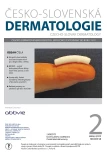Symmetrical, Drug-Induced, Intertriginous and Flexural Exanthema. Case Report
Authors:
P. Ďuríková; N. Andrýsková
Authors‘ workplace:
Dermatovenerologická klinika LFUK a UN Bratislava, prednostka prof. MUDr. Mária Šimaljaková, PhD., MPH, MHA
Published in:
Čes-slov Derm, 98, 2023, No. 2, p. 100-104
Category:
Case Reports
Overview
The authors describe a case of a 90-year-old patient with a rash that appeared a few hours after administration of amoxicillin clavulanate. Based on the presence of characteristic clinical features, a diagnosis of symmetrical drug - -related intertriginous and flexural exanthema was established. From the differential diagnosis point of view, the case was also complicated by the coexistence of artificially induced edema of the lower limb. The authors present an overview of current knowledge on diagnostic and therapeutic options in the management of this rare clinical entity.
Keywords:
amoxicillin – symmetrical drug-related intertriginous and flexural exanthema
Sources
1. ANDERSEN, K. E., HJORTH, N., MENNE, T. The baboon syndrome: systemically-induced allergic contact dermatitis. Contact Derm., 1984,10, p. 97 – 100.
2. BARBAUD, A., TRÉCHOT, P., GRANEL, F. et al. A baboon syndrome induced by intravenous human immunoglobulins: Report of a case and immunological analysis. Dermatology, 1999, 199(3), p. 258–260.
3. BONAMIGO, R. R., BOTTEGA, G. B., STAUB, F. L. et al. Bullous SDRIFE and Covid‐19. Int. J. Dermatol., 2021, 61(3), p. 372–374
4. CZARKOWSKI, W., BISCH, S., MLECZKO, K. et al. Polypragmasy as a therapeutic problem among palliative and geriatric patients. Med. Paliatywna, 2021, 13(1), p. 24–31.
5. DE RISI-PUGLIESE, T., BARAILLER, H., HAMELIN, A. et al. Symmetrical drug-related intertriginous and flexural exanthema: A little-known drug allergy. J. Allergy Clin. Immunol. Pract., 2020, 8(9), p. 1–5.
6. DIAS, J. A., CAMPOS, L. M., SCHMITT, J. V. et al. Symmetrical intertriginous and flexural exanthema related to the use of Paracetamol. An. Bras. Dermatol., 2021, 96(5), p. 646–647
7. DING, R., CHEO, F. F., LEE, H. Y. et al. Celecoxib and bullous symmetrical drug-related intertriginous and flexural exanthem (SDRIFE). J. Allergy Clin. Immunol. Pract., 2023, 5(22).
8. ELMARIAH, S. B., CHEUNG, W., WANG, N. et al., Systemic drug-related intertriginous and flexural exanthema (SDRIFE). Dermatol. Online J., 2009, 15(8), p. 597–599.
9. HAYNES, D., PENA, Z., WHITE, K. et al. Symmetric Drug-Related Intertriginous and Flexural Exanthema. Cutis, 2020, 105(06), p. 25–27.
10. HÄUSERMANN, P., HARR, T., BIRCHER, A. J. Baboon syndrome resulting from systemic drugs: is there strife between SDRIFE and allergic contact dermatitis syndrome? Contact Derm., 2004, 51, p. 297–310.
11. HUYNH, T., HUGHEY, L. C., MCKAY, K. et al. Systemic drug-related intertriginous and flexural exanthema from radio contrast media: A series of 3 cases. JAAD Case Rep., 2015, 1(3), p. 47–149.
12. National Institute of Diabetes and Digestive and Kidney Diseases. Adverse Drug Reaction Probability Scale (Naranjo) in Drug Induced Liver Injury. 2019, PMID: 31689026.
13. NEMŠOVSKÁ, J. Liekove hypersenzitivne reakcie: klasifikacia a patogeneza (1. časť). Čes-slov. Derm., 2019, 94(3), s. 99–107
14. NEMŠOVSKÁ, J. Liekové hypersenzitívne reakcie (2. časť). Čes-slov. Derm., 2019, 94(5), s. 192–202.
15. NESPOULOUS, L., MATEI I., CHARISSOUX, C. B. et al. Symmetrical drug-related intertriginous and flexural exanthema (SDRIFE) associated with pristinamycin, secnidazole, and Nefopam, with a review of the literature. Contact Derm., 2018, 79(6), p. 378–380.
16. ÖZKAYA, E., BABUNA, G. A challenging case: Symmetrical drug related intertriginous and flexural exanthem, fixed drug eruption, or both?. Pediatr. Dermatol., 2011, 28(6), p. 711–714.
17. PICHLER, W. J. The P-I concept: Pharmacological interaction of drugs with immune receptors. World Allergy Organ. J., 2008, 1(6), p. 96–102.
18. RABE, E. Das artifizielle Lymphödem aus klinischer Sicht. Wien Med Wochenschr, 1999, 149 (2–4), p. 95.
19. TAN, S. C., TAN, J. W. L. Symmetrical drug-related intertriginous and flexural exanthema. Current Opinion in Allergy. Clin. Immunol., 2011, 11(4), p. 313–318.
20. TORRES, M. J., ROMANO, A., CELIK, G. et al. Approach to the dignosis of drug hypersensitivity reactions: similarities and differences between Europe and North America. Clin. Transl. Allergy, 2017, 7, p. 7–25.
21. VALKS, R., BUEZO, G. F., DAUDÉN, E. et al. Eccrine squamous syringometaplasia in intertriginous areas. Br. J. Dermatol., 1996, 134(5), p. 984–986.
22. WADHWA, D., MAHAJAN, V. K. Systemic drug related intertriginous and flexural exanthema (SDRIFE) or intertriginous drug eruption: A matter of semantics. Our Dermatol. Online, 2019, 10(1), p. 48–50.
23. WOLF, R., ORION, E., MATZ, H. The baboon syndrome or intertriginous drug eruption: A report of eleven cases and a second look at its pathomechanism. Dermatol. Online J., 2003, 9(3).
24. WOLF, R., TÜZLÜN, Y. Baboon syndrome and toxic erythema of chemotherapy: Fold (intertriginous) dermatoses. Clin. Dermatol., 2015, 33, p. 462–465.
Labels
Dermatology & STDs Paediatric dermatology & STDsArticle was published in
Czech-Slovak Dermatology

2023 Issue 2
Most read in this issue
- Atopic Dermatitis: Current Guidelines for Diagnosis and Treatment. Part I.
- Bullous Lesions on the Acral Parts of the Limbs – Acral Peeling Skin Syndrome. Minireview
- BIOREP – Biologic/Targeted Therapy Registry: 2022 Summary Report
- Odborné akce 2023
